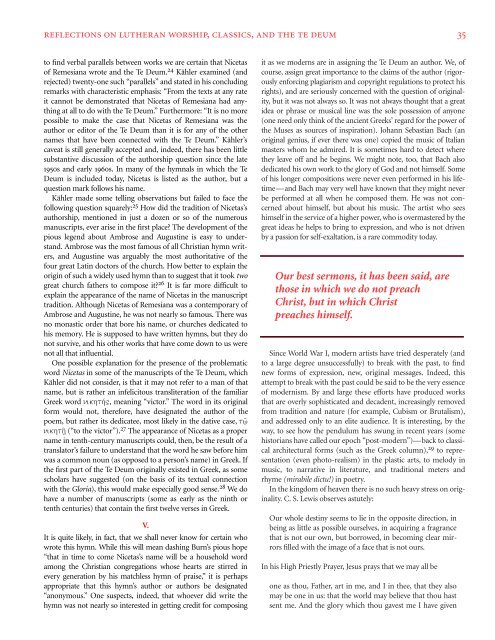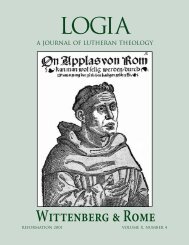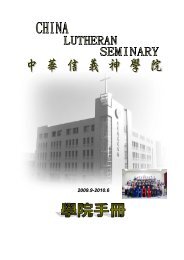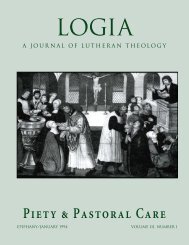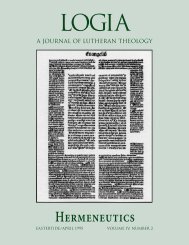05-4 Theology of the..
05-4 Theology of the..
05-4 Theology of the..
Create successful ePaper yourself
Turn your PDF publications into a flip-book with our unique Google optimized e-Paper software.
REFLECTIONS ON LUTHERAN WORSHIP, CLASSICS, AND THE TE DEUM 35<br />
to find verbal parallels between works we are certain that Nicetas<br />
<strong>of</strong> Remesiana wrote and <strong>the</strong> Te Deum. 24 Kähler examined (and<br />
rejected) twenty-one such “parallels” and stated in his concluding<br />
remarks with characteristic emphasis: “From <strong>the</strong> texts at any rate<br />
it cannot be demonstrated that Nicetas <strong>of</strong> Remesiana had anything<br />
at all to do with <strong>the</strong> Te Deum.” Fur<strong>the</strong>rmore: “It is no more<br />
possible to make <strong>the</strong> case that Nicetas <strong>of</strong> Remesiana was <strong>the</strong><br />
author or editor <strong>of</strong> <strong>the</strong> Te Deum than it is for any <strong>of</strong> <strong>the</strong> o<strong>the</strong>r<br />
names that have been connected with <strong>the</strong> Te Deum.” Kähler’s<br />
caveat is still generally accepted and, indeed, <strong>the</strong>re has been little<br />
substantive discussion <strong>of</strong> <strong>the</strong> authorship question since <strong>the</strong> late<br />
1950s and early 1960s. In many <strong>of</strong> <strong>the</strong> hymnals in which <strong>the</strong> Te<br />
Deum is included today, Nicetas is listed as <strong>the</strong> author, but a<br />
question mark follows his name.<br />
Kähler made some telling observations but failed to face <strong>the</strong><br />
following question squarely: 25 How did <strong>the</strong> tradition <strong>of</strong> Nicetas’s<br />
authorship, mentioned in just a dozen or so <strong>of</strong> <strong>the</strong> numerous<br />
manuscripts, ever arise in <strong>the</strong> first place The development <strong>of</strong> <strong>the</strong><br />
pious legend about Ambrose and Augustine is easy to understand.<br />
Ambrose was <strong>the</strong> most famous <strong>of</strong> all Christian hymn writers,<br />
and Augustine was arguably <strong>the</strong> most authoritative <strong>of</strong> <strong>the</strong><br />
four great Latin doctors <strong>of</strong> <strong>the</strong> church. How better to explain <strong>the</strong><br />
origin <strong>of</strong> such a widely used hymn than to suggest that it took two<br />
great church fa<strong>the</strong>rs to compose it 26 It is far more difficult to<br />
explain <strong>the</strong> appearance <strong>of</strong> <strong>the</strong> name <strong>of</strong> Nicetas in <strong>the</strong> manuscript<br />
tradition. Although Nicetas <strong>of</strong> Remesiana was a contemporary <strong>of</strong><br />
Ambrose and Augustine, he was not nearly so famous. There was<br />
no monastic order that bore his name, or churches dedicated to<br />
his memory. He is supposed to have written hymns, but <strong>the</strong>y do<br />
not survive, and his o<strong>the</strong>r works that have come down to us were<br />
not all that influential.<br />
One possible explanation for <strong>the</strong> presence <strong>of</strong> <strong>the</strong> problematic<br />
word Nicetas in some <strong>of</strong> <strong>the</strong> manuscripts <strong>of</strong> <strong>the</strong> Te Deum, which<br />
Kähler did not consider, is that it may not refer to a man <strong>of</strong> that<br />
name, but is ra<strong>the</strong>r an infelicitous transliteration <strong>of</strong> <strong>the</strong> familiar<br />
Greek word nikhthv", meaning “victor.” The word in its original<br />
form would not, <strong>the</strong>refore, have designated <strong>the</strong> author <strong>of</strong> <strong>the</strong><br />
poem, but ra<strong>the</strong>r its dedicatee, most likely in <strong>the</strong> dative case, tw'/<br />
nikhth'/ (“to <strong>the</strong> victor”). 27 The appearance <strong>of</strong> Nicetas as a proper<br />
name in tenth-century manuscripts could, <strong>the</strong>n, be <strong>the</strong> result <strong>of</strong> a<br />
translator’s failure to understand that <strong>the</strong> word he saw before him<br />
was a common noun (as opposed to a person’s name) in Greek. If<br />
<strong>the</strong> first part <strong>of</strong> <strong>the</strong> Te Deum originally existed in Greek, as some<br />
scholars have suggested (on <strong>the</strong> basis <strong>of</strong> its textual connection<br />
with <strong>the</strong> Gloria), this would make especially good sense. 28 We do<br />
have a number <strong>of</strong> manuscripts (some as early as <strong>the</strong> ninth or<br />
tenth centuries) that contain <strong>the</strong> first twelve verses in Greek.<br />
V.<br />
It is quite likely, in fact, that we shall never know for certain who<br />
wrote this hymn. While this will mean dashing Burn’s pious hope<br />
“that in time to come Nicetas’s name will be a household word<br />
among <strong>the</strong> Christian congregations whose hearts are stirred in<br />
every generation by his matchless hymn <strong>of</strong> praise,” it is perhaps<br />
appropriate that this hymn’s author or authors be designated<br />
“anonymous.” One suspects, indeed, that whoever did write <strong>the</strong><br />
hymn was not nearly so interested in getting credit for composing<br />
it as we moderns are in assigning <strong>the</strong> Te Deum an author. We, <strong>of</strong><br />
course, assign great importance to <strong>the</strong> claims <strong>of</strong> <strong>the</strong> author (rigorously<br />
enforcing plagiarism and copyright regulations to protect his<br />
rights), and are seriously concerned with <strong>the</strong> question <strong>of</strong> originality,<br />
but it was not always so. It was not always thought that a great<br />
idea or phrase or musical line was <strong>the</strong> sole possession <strong>of</strong> anyone<br />
(one need only think <strong>of</strong> <strong>the</strong> ancient Greeks’ regard for <strong>the</strong> power <strong>of</strong><br />
<strong>the</strong> Muses as sources <strong>of</strong> inspiration). Johann Sebastian Bach (an<br />
original genius, if ever <strong>the</strong>re was one) copied <strong>the</strong> music <strong>of</strong> Italian<br />
masters whom he admired. It is sometimes hard to detect where<br />
<strong>the</strong>y leave <strong>of</strong>f and he begins. We might note, too, that Bach also<br />
dedicated his own work to <strong>the</strong> glory <strong>of</strong> God and not himself. Some<br />
<strong>of</strong> his longer compositions were never even performed in his lifetime—and<br />
Bach may very well have known that <strong>the</strong>y might never<br />
be performed at all when he composed <strong>the</strong>m. He was not concerned<br />
about himself, but about his music. The artist who sees<br />
himself in <strong>the</strong> service <strong>of</strong> a higher power, who is overmastered by <strong>the</strong><br />
great ideas he helps to bring to expression, and who is not driven<br />
by a passion for self-exaltation, is a rare commodity today.<br />
Our best sermons, it has been said, are<br />
those in which we do not preach<br />
Christ, but in which Christ<br />
preaches himself.<br />
nb<br />
Since World War I, modern artists have tried desperately (and<br />
to a large degree unsuccessfully) to break with <strong>the</strong> past, to find<br />
new forms <strong>of</strong> expression, new, original messages. Indeed, this<br />
attempt to break with <strong>the</strong> past could be said to be <strong>the</strong> very essence<br />
<strong>of</strong> modernism. By and large <strong>the</strong>se efforts have produced works<br />
that are overly sophisticated and decadent, increasingly removed<br />
from tradition and nature (for example, Cubism or Brutalism),<br />
and addressed only to an elite audience. It is interesting, by <strong>the</strong><br />
way, to see how <strong>the</strong> pendulum has swung in recent years (some<br />
historians have called our epoch “post-modern”)—back to classical<br />
architectural forms (such as <strong>the</strong> Greek column), 29 to representation<br />
(even photo-realism) in <strong>the</strong> plastic arts, to melody in<br />
music, to narrative in literature, and traditional meters and<br />
rhyme (mirabile dictu!) in poetry.<br />
In <strong>the</strong> kingdom <strong>of</strong> heaven <strong>the</strong>re is no such heavy stress on originality.<br />
C. S. Lewis observes astutely:<br />
Our whole destiny seems to lie in <strong>the</strong> opposite direction, in<br />
being as little as possible ourselves, in acquiring a fragrance<br />
that is not our own, but borrowed, in becoming clear mirrors<br />
filled with <strong>the</strong> image <strong>of</strong> a face that is not ours.<br />
In his High Priestly Prayer, Jesus prays that we may all be<br />
one as thou, Fa<strong>the</strong>r, art in me, and I in <strong>the</strong>e, that <strong>the</strong>y also<br />
may be one in us: that <strong>the</strong> world may believe that thou hast<br />
sent me. And <strong>the</strong> glory which thou gavest me I have given


